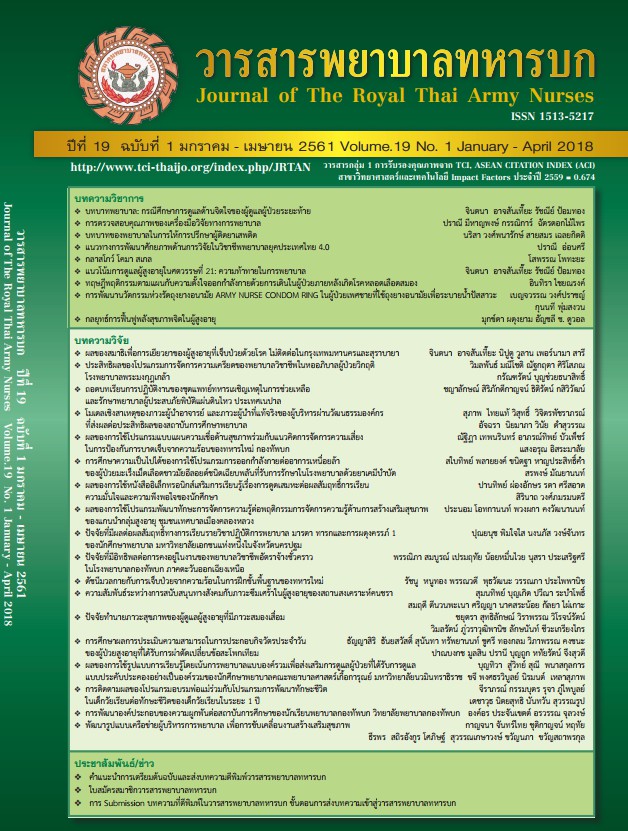พัฒนารูปแบบเครือข่ายผู้บริหารการพยาบาล เพื่อการขับเคลื่อนงานสร้างเสริมสุขภาพ
Keywords:
children and juvenileAbstract
การวิจัยเชิงปฏิบัติการแบบมีส่วนร่วมนี้มีวัตถุประสงค์เพื่อพัฒนาและประเมินผลรูปแบบเครือข่ายผู้บริหารการพยาบาลเพื่อการขับเคลื่อนงานสร้างเสริมสุขภาพ ผู้ร่วมดำเนินการวิจัยเลือกแบบเจาะจงตามคุณสมบัติที่กำหนด ประกอบด้วยผู้บริหารการพยาบาลระดับเขต จำนวน 5 คน ระดับจังหวัดจำนวน 10 คน ระดับอำเภอ 10 คน รวมทั้งสิ้น 25 คน ดำเนินการวิจัยแบ่งเป็น2 ระยะ ได้แก่ ระยะก่อนและระยะพัฒนารูปแบบเครือข่ายผู้บริหารการพยาบาลฯ เก็บรวบรวมข้อมูลโดยผสานวิธี ทั้งข้อมูลเชิงปริมาณและเชิงคุณภาพ จากแหล่งข้อมูลทุติยภูมิและปฐมภูมิ ข้อมูลเชิงปริมาณวิเคราะห์โดยใช้สถิติเชิงพรรณนา และการทดสอบค่าที (pair t-test) ข้อมูลเชิงคุณภาพ เป็นการวิเคราะห์เชิงเนื้อหา (content analysis) ข้อมูลจากการทบทวนวรรณกรรมการสนทนากลุ่มและการสังเกต ผลการวิจัยพบว่า 1) รูปแบบเครือข่ายผู้บริหารการพยาบาลฯ เป็นรูปแบบที่จัดตั้งขึ้นอย่างเป็นทางการภายในเขตสุขภาพประกอบด้วย ผู้บริหารการพยาบาลระดับประเทศ เขต จังหวัด และอำเภอ มีบทบาทหลักในการกำหนดแผนงานพัฒนางานสร้างเสริมสุขภาพ สนับสนุนทรัพยากร ให้คำปรึกษา และติดตามประเมินผล 2) ผลของรูปแบบเครือข่ายผู้บริหารการพยาบาลฯ ทำให้เป็นที่ยอมรับของภาคีเครือข่าย และมีส่วนร่วมให้โครงการสร้างเสริมสุขภาพบรรลุวัตถุประสงค์ มีการขยายผลไปยังชุมชนและกิจกรรมสร้างเสริมสุขภาพอื่น ๆ ร้อยละ 100 ประชาชนมีความรู้ในการดูแลสุขภาพตนเองเพิ่มขึ้น ทั้ง 5 พื้นที่ (ร้อยละที่เพิ่มขึ้น 87.00 เป็น 89.50, 61.42 เป็น 81.43, 76.50 เป็น 88.90, 64.60 เป็น 85.50 และ 48.30 เป็น 88.40) ดังนั้นการกำหนดรูปแบบองค์ประกอบ และบทบาทสมาชิกในเครือข่ายอย่างมีวัตถุประสงค์เพื่อการขับเคลื่อนงานให้บรรลุผลสำเร็จ จึงเป็นสิ่งจำเป็นและสำคัญ
Model Development of Chief Nursing Officer’s Network for Health Promotion
This participatory action research aimed to develop and assess a model of networks of chief nursing officers (CNO Network) for health promotion in a purposive sample of 25 chief nursing officers selected from those with specified inclusion criteria, including 5 from the regional level, 10 from the provincial level and 10 from the district level. The study covered two phases: phase 1, pre-implementation and phase 2, CNO network model development. Quantitative and qualitative data were collected using mixed methods from primary and secondary sources. Quantitative data were analyzed with descriptive statistics and paired t-test; and content analysis was performed for quantitative data obtained from literature review, focus group discussions, and observations. The results showed that: (1) the CNO Network for Health Promotion in each health region comprised CNOs from the central, regional, provincial and district levels and had key = 4.07); and (2) in moving health promotion efforts through the NCO networks, the work was acceptable to all network members that took part in making the program reach its objectives and expand to all (100%) target communities with various health promotion activities; and the people had higher levels of knowledge about self-care in all five localities (rising from 87.0% to 89.5%, 61.4% to 81.4%, 76.5% to 88.9%, 64.6% to 85.5% and 48.3% to 88.4%, respectively). So it is concluded that, defining the role and function of members in the network are designed to achieve the achievement of the task. It is essential and important.
Downloads
Downloads
Published
How to Cite
Issue
Section
License
บทความหรือข้อคิดเห็นใดใดที่ปรากฏในวารสารพยาบาลทหารบกเป็นวรรณกรรมของผู้เขียน ซึ่งบรรณาธิการหรือสมาคมพยาบาลทหารบก ไม่จำเป็นต้องเห็นด้วย
บทความที่ได้รับการตีพิมพ์เป็นลิขสิทธิ์ของวารสารพยาบาลทหารบก
The ideas and opinions expressed in the Journal of The Royal Thai Army Nurses are those of the authors and not necessarily those
of the editor or Royal Thai Army Nurses Association.






